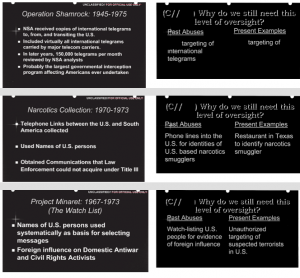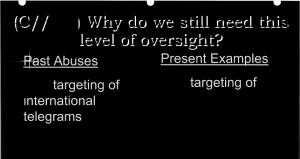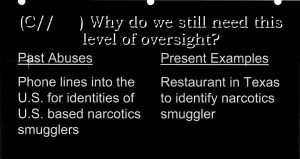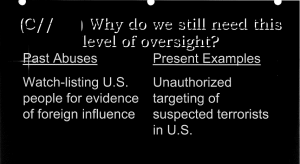
Several days ago I wrote,
Both Goldsmith’s memo (see PDF 14) and the Draft NSA IG Report (PDF 10) make it clear that, in addition to temporarily shutting down the Internet dragnet, the March 19, 2004 modifications to the program narrowed the program’s focus to exclude the Iraqi Intelligence figures who had previously been included, suggesting that Goldsmith only felt he could approve the program for terrorists.
Wait, what?
I’ve known — and written — about this detail in the past. But I hadn’t really put together what it means.
Post-hospital confrontation changes include the exclusion of Iraqi-related targets
Here’s what the two passages say. Goldsmith’s (still heavily redacted) memo reveals that, along with other modifications George Bush made on March 19, 2004 in response to the DOJ resignation threats (notably, temporarily shutting down the Internet dragnet) he also “clarified” the scope of the program.
In the March 19, 2004 Modification, the President also clarified the scope of the authorization [redacted]. He made clear that the Authorization applied where there were reasonable grounds to believe that a communicant was an agent of an international terrorist group [redacted]
The NSA IG Report explains that “clarification” halted using the Presidential Surveillance Program authority against the Iraqi Intelligence Service.
(TS//SI//NF) Iraqi Intelligence Service. For a limited period of time surrounding the 2003 invasion of lraq, the President authorized the use of PSP authority against the Iraqi Intelligence Service. On 28 March 2003, the DCI determined that, based on then current intelligence, the Iraqi Intelligence service was engaged in terrorist activities and presented a threat to U.S. interests in the United States and abroad. Through the Deputy DCI, Mr. Tenet received the President’s concurrence that PSP authorities could be used against the Iraqi Intelligence Service. NSA ceased using the Authority for this purpose in March 2004. [my emphasis]
There may be a perfectly innocent explanation for this.
At precisely that time, Goldsmith was trying to rein in the government’s rendition program to prevent the rendition of Iraqis protected under international law governing occupation. And, at what appears to have been the same time, DOD was for the first time making a distinction between between Iraqis detained and interrogated as former regime officials and Iraqis detained and interrogated as leaders of the insurgency. Clearly, up until that point, Bush had been using the rules invented to hunt terrorists in his Iraq War, creating all sorts of legal problems. So it would be unsurprising if Goldsmith used the resignation threats to force Bush to stop targeting Iraqi officials as terrorists when they were really legal opponents in a war.
The Iraqi-related illegal wiretapping targets must include US-based collection
Except that doesn’t make sense.
That’s because, whatever violations of international law Bush was committing in Iraq, illegal spying on Iraqis was almost certainly not one of them. Nothing prevented the government from spying on Iraqis, and very little spying on Iraqis in Iraq would involve the kind of US collection that implicated his illegal wiretap program.
Which is why the IG Report’s description of an Iraqi intelligence “threat to U.S. interests in the United States” gives me pause.
The illegal program, after all, was focused on US metadata and content collection to find threats (what it called “terrorists”) in the United States. Both the method and location of collection only make sense if you’re hunting communications with at least one, if not both, sides in the US.
There was no real known threat posed by Iraqi governmental interests in the US, in part because the US military chased the Iraqi government underground so quickly. And yet, for it to be something tied into the resignation threats, some significant spying must have been going on.
The obvious guess — and at this point it is just a guess — would be they used the illegal wiretap program to hunt down people Cheney’s minions claimed helped Iraq’s cause here in the US.
You know? Iraqi intelligence assets? Like anti-war activists?
Some data points that might support Bush’s use of his illegal program against anti-war activists
Again, at this point, this is just a guess, one that would be thoroughly unsurprising but is not supported by hard facts.
But it’s worth remembering that Bush did roll out a domestic spying program to track anti-war activities, CIFA, the database for which was destroyed just weeks before NYT initially exposed Bush’s illegal program. We know there were ties between that program and heavy FBI investigations in the US. Then there’s the Antiwar investigation, started just weeks after the hospital confrontation, that used a counterterrorism purpose (a watchlist Antiwar posted) as the predicate to call for further investigation of Antiwar’s online publications, conducted in multiple cities. The Bush Administration was clearly conducting aggressive spying on anti-war activists, so it would be unsurprising to learn it used the threat of Iraqi involvement in the US to conduct illegal electronic surveillance.
Then there’s the suggestion in this NSA training program (from which the two slides above come — see this post for background) that NSA had a “present example” (in 2009) of an abuse akin to Project Minaret, in which a watchlist of citizens –largely critics of the Vietnam War — were surveilled in the name of tracking any foreign influence on them. Here’s Matthew Aid’s description of recent disclosures about that program.
As the Vietnam War escalated during Lyndon B. Johnson’s presidency, domestic criticism and protest movements abounded. Protesters surrounded the Pentagon in the fall of 1967 and two years later organized demonstrations and the Moratorium to End the War in Vietnam. The scale of the dissent angered Johnson as well as his successor, Richard Nixon. As fervent anti-communists, they wondered whether domestic protests were linked to hostile foreign powers, and they wanted answers from the intelligence community. The CIA responded with Operation Chaos, while the NSA worked with other intelligence agencies to compile watch lists of prominent anti-war critics in order to monitor their overseas communications. By 1969, this program became formally known as “Minaret.”
While the NSA slide describes the present example as “unauthorized targeting of suspected terrorists in the U.S.,” not targeting of anti-war activists, we know the collection shut down in March 2004 must have involved the targeting of people in the US based on a claim that some tie to Iraqi interests made them terrorists. Moreover, such targeting would be an exact parallel with Minaret (and while I haven’t discussed it yet, I am cognizant of Bernie Sanders’ recent questions about the targeting of members of Congress, as happened under Minaret and, for reasons explained in my earlier post, as the training program may allude to).
Again, I want to emphasize: this is just a wildarsed guess. though one consistent with what we know about Bush’s illegal program and his surveillance of anti-war activists generally.
Whatever it was, it was part of the package that almost led a bunch of DOJ officials to quit.





